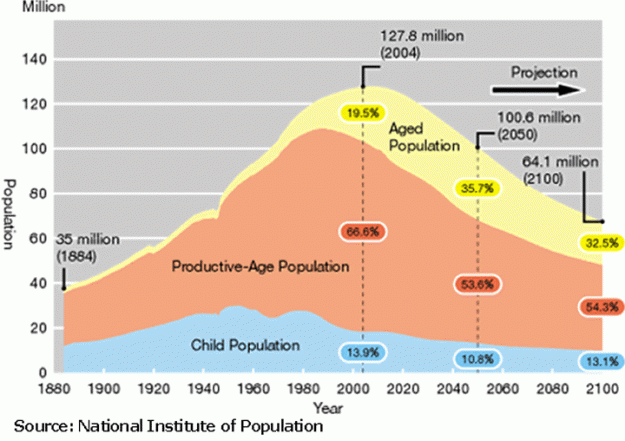Summary: Today we look at the future of Japan, and speculate at how well it will cope with the new industrial revolution. Their unique strengths (sometimes wrongly considered weaknesses) suggest that the 21st century might see the sun again rising over Japan. America too will face this challenge; we should watch and learn from Japan’s experiences — successful or otherwise. (1st of 2 posts today. It is a revised version of posts from 2013 and 2014)
Contents
- Falling population is a boon for Japan
- A new Industrial Revolution
- Japan: suited to be a star of the 21st Century
- For More Information
(1) Falling population is a boon for Japan
Japan’s government has worried about its overpopulation since the Meiji Restoration when they had about 3 million people (1868). They encouraged emigration to Korea, to no effect. They had 50 million in 1910, 100 million in 1967, and a peak in 2008 at 128 million — all crowded into a narrow urban belt along the coast. At their current level of fertility, by 2100 their population might be half of today’s, back to the level of 1930. If fertility continues to fall, population might fall to 60 million (1925) or even 50 million (1910).
The effect on Japan’s environment would be wonderful. Japan could become a garden with the cleaner technology of that future era (a common question in grade-school history will be “Teacher, what is ‘pollution’?”).
See this graph showing the coming evolution of the age distribution in Japan (source; see more information from their National Institute of Population and Social Security Research).

Many economists look at this data and conclude that Japan needs more immigration, otherwise their national income (GDP) will fall along with their population. The New York Times says Insular Japan Needs, but Resists, Immigration. The Washington Post says Strict immigration rules may threaten Japan’s future. These prescriptions for Japan show the limits of economics as a guide to public policy. GDP is not the only measure of a nation’s well-being, or even the best. Worse, economists sometimes see only linear trends of the past, blind to future developments visible even today.
A tool of 15th century labor protest
(2) A new Industrial Revolution
There have been several industrial revolutions. Somewhat arbitrarily, we had the first in 1750-1850, and the second in 1860-1920. Their productivity gains were not shared. Hence “sabotage”, as textile workers protested by throwing their wooden shoes (“sabot”) into the machines.
These rebellions grew in breath and scale, with peaks during the revolutions of 1848 and the 1917 Russian revolution. Frightened by those and the turmoil of the Great Depression — plus the need for high social cohesion to fight the two world wars and the cold war — the West’s elites decided that more sharing was necessary. That created the western societies we see today, with their large middle classes.
Now the information revolution has begun, so far the smallest in its effects on productivity. Massive job losses lie ahead from machines with rudimentary senses and powerful algorithms. Beyond that lie semi-intelligent machines and and even larger job losses.
Under our current system this will shift the shares of national income from labor to capital. How to share this revolutions vast productivity gains among the different classes might become a — or perhaps the — major social issue of the 21st century.
Failure might create massive structural unemployment. People cannot spend money they do not have, so aggregate demand will crash, as foreseen in 1962 by James Blish in A Life for the Stars, second in his Cities in Flight series
…
The cab came floating down out of the sky at the intersection and maneuvered itself to rest at the curb next to them with a finicky precision. There was, of course, nobody in it; like everything else in the world requiring an I.Q. of less than 150, it was computer-controlled.
The world-wide dominance of such machines, Chris’s father had often said, had been one of the chief contributors to the present and apparently permanent depression: the coming of semi-intelligent machines had created a second Industrial Revolution, in which only the most highly creative human beings, and those most fitted at administration, found themselves with any skills to sell which were worth the world’s money to buy.
Cyberpunk science fiction shows another future if current trends continue, a “nightmarish world of corporate control and extreme wealth disparities.”
ADVERTISEMENT
(2) Japan: a star of the 21st Century
Consider Japan’s special characteristics which make them an economic leader in the 21st century.
- A highly educated and hard-working people with a high-savings rate — the foundation for economic success).
- A homogeneous population with strong social cohesion — minimizing the domestic turbulence common in multi-ethnic societies when under stress.
- A shrinking labor force — able to more easily absorb the job destruction from automation.
These advantages are mutually reinforcing. A highly educated population suits the available jobs. A shrinking population more easily accommodates job losses from automation, which reduces the social stress of this transition (more about this here). Less social stress might facilitate adoption of new technology and methods. The obvious contrast is with America, and its growing population of increasingly poorly educated people, in a society fracturing by ethnicity, race, religion, and ideology.
America might look to Japan for ideas in the years to come. We do not appear to have many of our own. Without Japan’s advantages we might need bolder measures.
